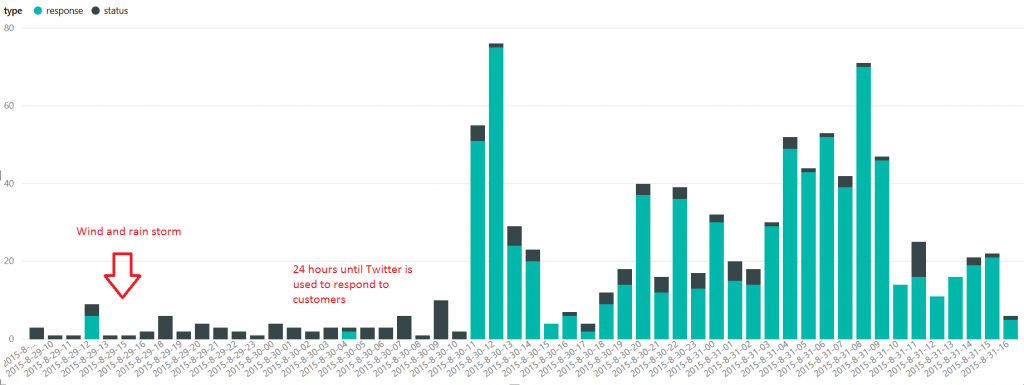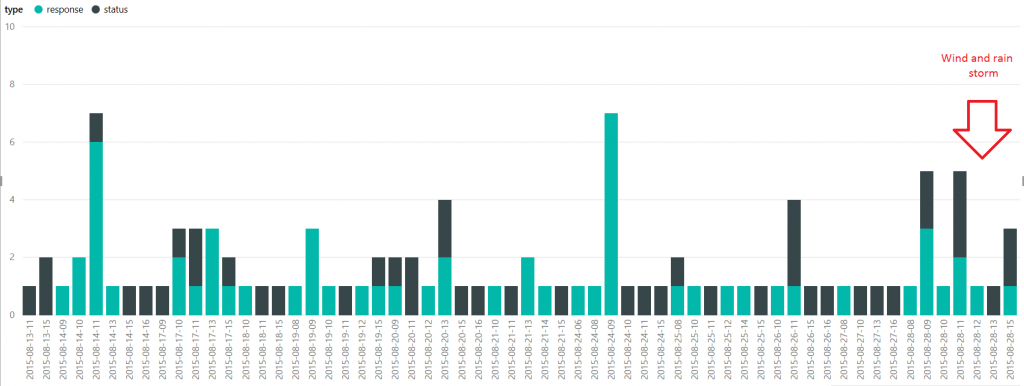BC Hydro made an amazing social media turnaround to communicate with customers in crisis! Go BC Hydro!
On August 29, 2015 high winds caused tree falls that took out BC Hydro power lines throughout BC’s Lower Mainland, Vancouver Island, Sunshine Coast leaving up to 500,000 customers without electricity. Many including me were without power for 48 hours.
BC Hydro’s web site was their primary channel for communicating with customers about extent of damage and expected time for repairs, but the site also went down during this time. H
They had used Twitter in the past to communicate with customers but they weren’t using it much on first day of crisis.
However on the second day of the crisis with 100,000+ customers still without power BC Hydro dramatically increased Twitter communication by responding directly to customer tweets about extent of damage and expected time for repairs.
To visualize this dramatic increase in BC Hydro Twitter usage I downloaded all @BCHydro tweets for August 29 and 30 from Twitter’s API using Python Tweepy and used Microsoft Power BI to create a visualization of BC Hydro tweet counts which is shown below.
Some notes on chart:
-
- x axis shows date and hour of day
- y-axis shows count of tweets
- ‘response’ tweets are light green part of bar
- ‘status’ tweets are dark green part of bar
You can see that on August 30 at 11 AM, about 28 hours after the storm hit, BC Hydro suddenly starts tweeting responses to customers’ questions. They continued for the next few days until their website was back up in addition to their regular ‘status’ tweets.
The chart clearly shows a very amazing social media turnaround! BC Hydro dramatically increased their use of Twitter to get customers answers and information. Go BC Hydro!
Note: the Twitter data was last updated Aug 31, 2015 at 16.45 PM PST.

Historically BC Hydro did not use Twitter this way. The chart below shows BC Hydro’s tweeting before the storm. They were tweeting once or twice per day with occasional spikes to 7 tweets per day.

The ‘response‘ category includes tweets by BC Hydro responding to a customer tweet. Example ‘response’ tweet:
2015-08-30 14:26:01, @Adamhillz Crews will be on site as soon as possible. Stay back from any downed lines and call 911 if it is on fire.
The ‘status‘ category includes tweets by BC Hydro about ongoing status of repair work etc. Example ‘status’ tweet:
2015-08-30 14:28:32, Crews have been brought in from across province, including Prince George, Terrace, Kamloops, Smithers, Vernon & Vancouver Island #bcstorm
FYI if anyone is interested, here is the text file with tweet text – bchtweets
Here is the Python code used to get the BC Hydro Tweets using the Twitter API.
import tweepy
#import MySQLdb
from datetime import datetime
import random
import sys, os
import json
from dateutil import tz
from tweet_auth import * #this is another .py file with the twitter api credentials
#get twitter auth
auth = tweepy.OAuthHandler(consumer_key, consumer_secret)
auth.set_access_token(access_token, access_token_secret)
api = tweepy.API(auth)
def main():
with open('bchtweets.csv', 'wb') as file:
for status in tweepy.Cursor(api.user_timeline, id='bchydro').items(1800):
file.write(str(status.created_at.replace(tzinfo=tz.gettz('UTC')).astimezone(tz.gettz('America/Los_Angeles')).replace(tzinfo=None)) + ', ' + status.text.encode('utf8') + '\n')
if __name__ == '__main__':
main()
Note that there is a separate file with my Twitter OAuth credentials that looks like the following. You just have to replace the ‘xxx…’ with your credentials.
#twitter api oauth credentials - replace with yours consumer_key = 'xxxxxxxxxxxxxxxxxxxxxxxxxxxxxxxxxxxx' consumer_secret = 'xxxxxxxxxxxxxxxxxxxxxxxxxxxxxxxxxx' access_token = 'xxxxxxxxxxxxx-xxxxxxxxxxxxxxxxxxxxxxxxxxxxxxxxx' access_token_secret = 'xxxxxxxxxxxxxxxxxxxxxxxxxxxxxxxxxxxxxxxxxx'